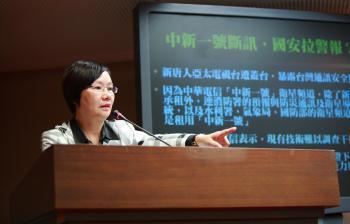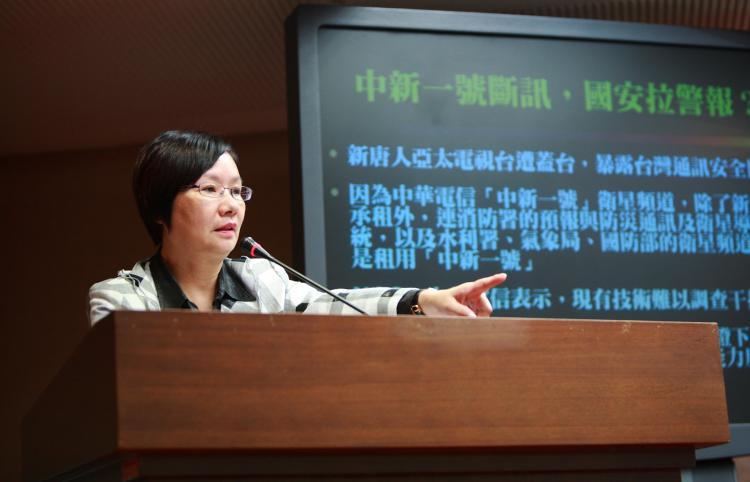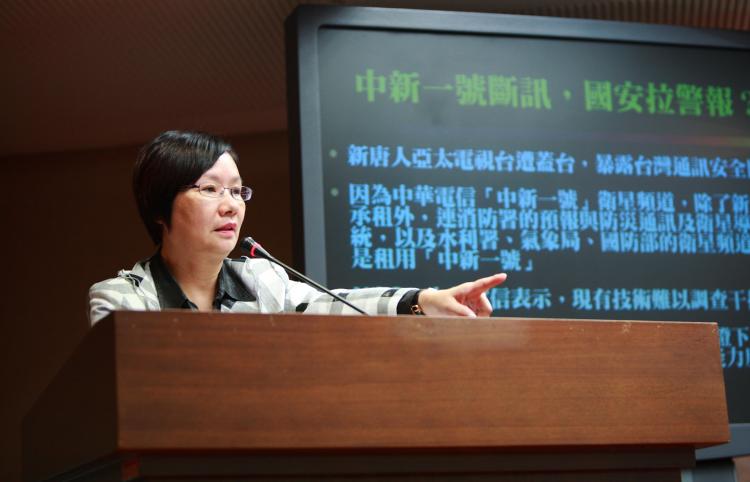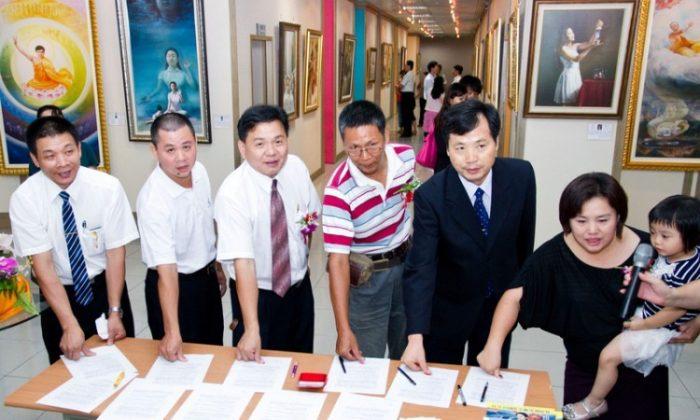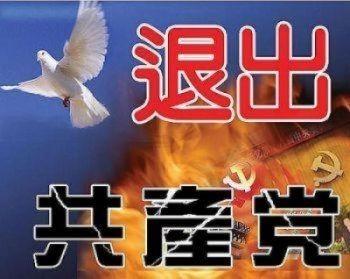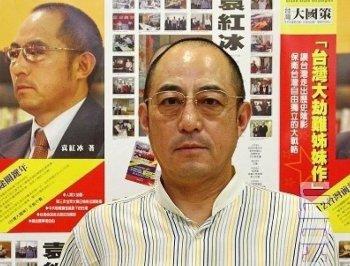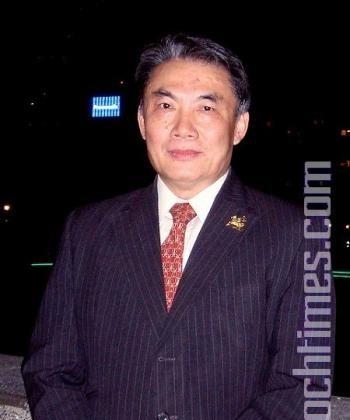TAIPEI, Taiwan—Taiwanese lawmakers on Oct 8. called for an investigation into the signal interruptions of the ST-1 satellite, which started on Sept. 17, and peaked on Oct. 1, during China’s National Day celebrations.
The satellite carries the signal for New Tang Dynasty Asia-Pacific Television (NTD APTV), an operation that is banned in mainland China and the subject of anger by the Chinese Communist Party (CCP) for its reportage on human rights abuses, religious freedom, and ethnic unrest in the country.
NTD leases the ST-1 satellite from Chunghwa Telecom, Taiwan’s largest telecommunications provider. Starting Sept. 17, signal interruptions were intermittent. Longer periods of interruption followed during nightly news broadcasts.
On Oct. 1, when the Chinese regime was celebrating the 60th anniversary of its taking power, NTD’s broadcast was effectively taken off the air the entire day.
The ST-1’s low band frequency covers all of Taiwan and 80 percent of mainland China.
Viewers filed complaints against Chunghwa Telecom, alleging that it failed to deal with the signal interruptions for several weeks.
On Oct. 8, legislators requested the National Communication Committee (NCC), Ministry of Communications, and Chunghwa Telecom, to expedite an investigation and find out the source of the apparent interference.
Several legislators openly stated their suspicions that the Chinese communist regime was behind it, and called on the NCC to defend Taiwan’s communication systems.
Legislator Kuo Wen-Cheng said the investigation team, composed of scholars and experts from Taiwan and abroad, should keep the National Security Bureau informed, and work closely with the Ministry of Defense, since the source of interruption is suspected of coming from China.
“We have been disrupted by China for so many days. It is a shame to say we do not know the source,” Legislator Kuo said.
Legislator Jiang Lian-Fu added that “The NCC needs to show our muscle when our satellite signal is interfered with. It is impossible that we cannot find the source.”
Peng Yun of the NCC noted that a similar incident took place before the Beijing Olympic Games last year. “This time we had the interruption before China’s National Day on October 1. The NCC is very serious about whether there is any political motive.”
Along with commercial applications, Taiwan relies on the ST-1 for communication during natural disasters. It also provides a video conference platform for warfare commanders, named “Army Sky-Frequency Moving Vehicle System.” It served effectively for video communication during earthquake which struck Taiwan on Sept. 21, 1999.
Though Chunghwa’s report is not finalized, an expert on electronic warfare interviewed by The Epoch Times indicated his suspicions that the interference came from the CCP-owned “Dongfanghong Aerospace Satellite,” which orbits close to the ST-1. The strategist spoke under condition of anonymity because of the political sensitivity of the allegation.
He said that the ST-1 satellite, jointly owned by Singapore and Taiwan, orbits above the earth at 88.0°E. China’s Dongfanghong satellite is only 0.4° away, he said.
Certain signals from the ST-1 are categorized as commercial telecommunication, and are afforded a lower degree of encryption, making them more vulnerable to interference.
By engaging slightly more transmitting power when needed, Dongfanghong can interfere with the signals from ST-1, he said.
For Taiwanese, the issue is not just one of media freedom. “Today the CCP will interfere with NTD, but tomorrow it may interfere with our national emergency communication,” executive of the Judicial Reform Foundation, Feng Zheng Lin, said at a press conference on Oct. 10. “The blocked signal was being broadcast directly into China so it is obvious who is responsible.”
Feng Jia Zhuang, Director of the Association of Taiwan Journalists said “The CCP use money to bribe media bodies, if this doesn’t work they will then use technology to block station signals.”
Lawmaker Wu Yu-Sheng said Taiwan needed to come up with a way to stop similar incidents happening again. “We exercise media freedom in Taiwan. The CCP blocking Taiwan’s signal—this makes me uncomfortable.”
Read the original Chinese article.
The satellite carries the signal for New Tang Dynasty Asia-Pacific Television (NTD APTV), an operation that is banned in mainland China and the subject of anger by the Chinese Communist Party (CCP) for its reportage on human rights abuses, religious freedom, and ethnic unrest in the country.
NTD leases the ST-1 satellite from Chunghwa Telecom, Taiwan’s largest telecommunications provider. Starting Sept. 17, signal interruptions were intermittent. Longer periods of interruption followed during nightly news broadcasts.
On Oct. 1, when the Chinese regime was celebrating the 60th anniversary of its taking power, NTD’s broadcast was effectively taken off the air the entire day.
The ST-1’s low band frequency covers all of Taiwan and 80 percent of mainland China.
Viewers filed complaints against Chunghwa Telecom, alleging that it failed to deal with the signal interruptions for several weeks.
On Oct. 8, legislators requested the National Communication Committee (NCC), Ministry of Communications, and Chunghwa Telecom, to expedite an investigation and find out the source of the apparent interference.
Several legislators openly stated their suspicions that the Chinese communist regime was behind it, and called on the NCC to defend Taiwan’s communication systems.
Legislator Kuo Wen-Cheng said the investigation team, composed of scholars and experts from Taiwan and abroad, should keep the National Security Bureau informed, and work closely with the Ministry of Defense, since the source of interruption is suspected of coming from China.
“We have been disrupted by China for so many days. It is a shame to say we do not know the source,” Legislator Kuo said.
Legislator Jiang Lian-Fu added that “The NCC needs to show our muscle when our satellite signal is interfered with. It is impossible that we cannot find the source.”
Peng Yun of the NCC noted that a similar incident took place before the Beijing Olympic Games last year. “This time we had the interruption before China’s National Day on October 1. The NCC is very serious about whether there is any political motive.”
Along with commercial applications, Taiwan relies on the ST-1 for communication during natural disasters. It also provides a video conference platform for warfare commanders, named “Army Sky-Frequency Moving Vehicle System.” It served effectively for video communication during earthquake which struck Taiwan on Sept. 21, 1999.
Though Chunghwa’s report is not finalized, an expert on electronic warfare interviewed by The Epoch Times indicated his suspicions that the interference came from the CCP-owned “Dongfanghong Aerospace Satellite,” which orbits close to the ST-1. The strategist spoke under condition of anonymity because of the political sensitivity of the allegation.
He said that the ST-1 satellite, jointly owned by Singapore and Taiwan, orbits above the earth at 88.0°E. China’s Dongfanghong satellite is only 0.4° away, he said.
Certain signals from the ST-1 are categorized as commercial telecommunication, and are afforded a lower degree of encryption, making them more vulnerable to interference.
By engaging slightly more transmitting power when needed, Dongfanghong can interfere with the signals from ST-1, he said.
For Taiwanese, the issue is not just one of media freedom. “Today the CCP will interfere with NTD, but tomorrow it may interfere with our national emergency communication,” executive of the Judicial Reform Foundation, Feng Zheng Lin, said at a press conference on Oct. 10. “The blocked signal was being broadcast directly into China so it is obvious who is responsible.”
Feng Jia Zhuang, Director of the Association of Taiwan Journalists said “The CCP use money to bribe media bodies, if this doesn’t work they will then use technology to block station signals.”
Lawmaker Wu Yu-Sheng said Taiwan needed to come up with a way to stop similar incidents happening again. “We exercise media freedom in Taiwan. The CCP blocking Taiwan’s signal—this makes me uncomfortable.”
Read the original Chinese article.
